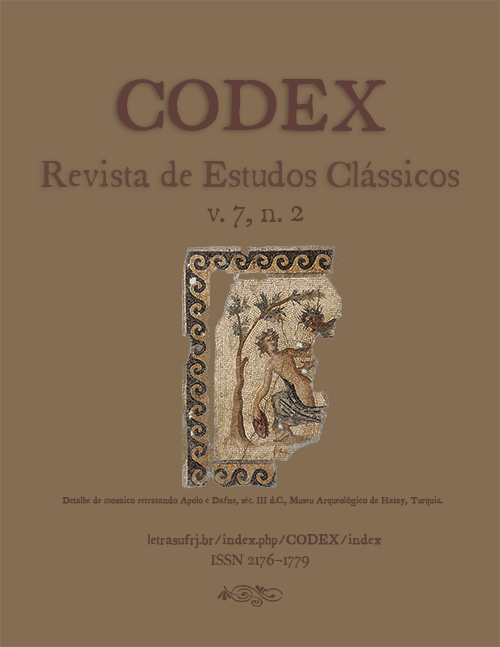The pólis in ecstasy: Figurations of Dionysus in Antiquity
DOI:
https://doi.org/10.25187/codex.v7i2.25767Keywords:
Dionysus, Ancient Religion, Ancient History, Ancient PoetryAbstract
Considering the imagery of the Ancient Greeks around the god Dionysus during the archaic period, as his characterizations are contained in poems and ceramics of this period, we intend to review some of the transformations that this deity’s representations have known from their earliest records up to the classical period. Exploring an interface with history and the various socio-economic and political transformations of this same period of time, we will follow how Dionysus changed from a minor status – characteristic of marginalized deities, even in the Homeric poems, for example – to acquire the importance that highlights him as the main divinity of a major festival such as the Great Dionysia in Athens, during the fifth century. Let us look at the various ambiguities inherent in the myths of the god, seeking to suggest how the historical facts outlined here may have been thus reflected in the mythical figurations which the Hellenic peoples of that period proposed in their artistic works.Downloads
References
Referências
Bibliografia primária
CAMPBELL, David (ed.). Greek Lyric I: Sappho and Alceus. Cambridge; London: Harvard University Press, 1982.
HERODOTUS. The Histories. With an English translation by A. D. Godley. Cambridge : Harvard University Press, 1920.
HOMER. Homeri Odyssea. Edidit H. van Thiel. New York: Hildesheim, 1991.
______. Ilias. Edidit M. West. Leipzig: Saur, 2000.
PAUSANIAS. Pausaniae Graeciae Descriptio. 3 vols. Leipzig: Teubner, 1903.
______. Pausanias’ Description of Greece. With an English Translation by W. H. S. Jones and H. A. Ormerod in 4 Volumes. Cambridge; London: Harvard University Press; William Heinemann, 1918.
RIBEIRO JR., Wilson Alves (Ed.). Hinos homéricos: Tradução, notas e estudo. São Paulo: Editora UNESP, 2010.
WEST, Martin L. Iambi et elegi Graeci ante Alexandrum cantati. 2. ed. aucta atque emendata. Oxford: Oxford University Press, 1992.
Bibliografia secundária
ALMEIDA, Joseph. Justice as an Aspect of the Polis Idea in Solon’s Political Poems: A Reading of the Fragments in Light of the Researches of the New Classical Archaeology. Leiden; Boston: Brill, 2003.
BACELAR, Agatha Pitombo. Pégase d’Eleuthères: d’une légende de transmission tardive au mythe étiologique « re-enacted ». Codex, v. 1, n. 2 (2009), p. 145-65.
BURKERT, Walter. Griechische Religion der archaischen und klassischen Epoche. Zweite, überarbeitete und erweiterte Auflage. Stuttgart: Verlag W. Kohlhammer, 2011 [orig. 1977].
CORRÊA, Paula da Cunha. Armas e varões: A guerra na lírica de Arquíloco. 2. ed. rev. e ampl. São Paulo: Unesp, 2009 [orig. 1998].
CSAPO, Eric. Riding the phallus for Dionysus: Iconology, ritual, and gender-role de/construction. Phoenix, vol. 51, 3-4 (1997), p. 253-95.
DABDAB TRABULSI, José Antonio. Dionisismo, poder e sociedade na Grécia até o fim da época clássica. Belo Horizonte: Humanitas; Editora UFMG, 2004 [orig. 1990].
DODDS, Eric. Introduction. In: EURIPIDES. Bacchae. Edited with introduction and commentary by E. R. Dodds. Second Edition. Oxford: Clarendon Press, 1963 [orig. 1944], p. xi-lix.
GARCÍA, John. Symbolic Action in the Homeric Hymns: The Theme of Recognition. Classical Antiquity, Vol. 21, N. 1 (2002), p. 5-39.
ISLER-KERÉNYI, Cornelia. Komasts, Mythic Imaginary, and Ritual. In: CSAPO, E.; MILLER, M. (Ed.). The origins of theater in ancient Greece and beyond: from ritual to drama. Cambridge: Cambridge University Press, 2007, p. 77-95.
JEANMAIRE, Henri. Dionysos: Histoire du culte de Bacchus. Paris: Payot, 1970.
NAGY, Gregory. Early Greek views of poets and poetry. In: KENNEDY, George A. (Ed.). The Cambridge History of Literary Criticism: Vol. 1. Classical Criticism. Cambridge: Cambridge University Press, 2008, p. 1-77.
NOBILI, Cecilia. L’Inno Omerico a Dioniso (Hymn. Hom. VII) e Corinto. ACME, Annali della Facoltà di Lettere e Filosofia dell’Università degli Studi di Milano, LXII, 3, Setembre-Dicembre, 2009, p. 3-35. Disponível em: http://www.ledonline.it/acme/allegati/Acme-09-III-01-Nobili.pdf. Acesso em: 21 abr. 2019.
OLIVEIRA, Leonardo Teixeira de. O ditirambo de Arquíloco a Simônides: Uma introdução às fontes primárias. 2012. 77 f. Monografia (Bacharelado em Letras) – Setor de Ciências Humanas, Letras e Artes, Universidade Federal do Paraná, Curitiba. 2012.
OSBORNE, Robin. Classical landscape with figures: the ancient Greek city and its countryside. London: George Philip, 1987.
OTTO, Walter F. Dionysus: Myth and cult. Translated with an Introduction by Robert B. Palmer. Bloomington; Indianapolis: Indiana University Press, 1965 [orig. 1933].
PALMER, Robert B. Introduction. In: OTTO, Walter F. Dionysus: Myth and cult. Translated with an Introduction by Robert B. Palmer. Bloomington; Indianapolis: Indiana University Press, 1965 [orig. 1933], p. ix-xi.
RIDGEWAY, William. The origin of tragedy: With special reference to the Greek tragedians. Cambridge: University Press, 1910.
ROHDE, Erwin. Psyche: Seelencult und Unsterblichkeitsglaube der Griechen. Freiburg i. B.; Leipzig: Akademische Verlagsbuchhandlung von J. C. B. Mohr (Paul Siebeck), 1894.
ROTHWELL, Kenneth. Nature, Culture, and the Origins of Greek Comedy: A Study of Animal Choruses. Cambridge: Cambridge University Press, 2007.
SEAFORD, Richard. Reciprocity and Ritual: Homer and Tragedy in the Developing City-State. Oxford: Clarendon Press, 1994.
______. Dionysos. London; New York: Routledge, 2006.
SILVA, Rafael. Arqueologias do drama: uma arqueologia dramática. 708 f. Dissertação (Mestrado em Estudos Clássicos) – Faculdade de Letras da Universidade Federal de Minas Gerais, Belo Horizonte. 2018.
SOURVINOU-INWOOD, Christiane. Tragedy and Athenian religion. Lanham; Boulder; New York; Oxford: Lexington Books, 2003.
SOUZA, Eudoro. Poética: Introdução. In: ARISTÓTELES. Poética. Tradução, Prefácio, Introdução, Comentário e Apêndices de Eudoro de Sousa. Lisboa: Imprensa Nacional; Casa da Moeda, 1986, p. 13-102.
WEST, Martin. The Early Chronology of Attic Tragedy. The Classical Quarterly, Vol. 39, n. 1 (1989), p. 251-4.
Downloads
Published
How to Cite
Issue
Section
License
This work is licensed under a Creative Commons Attribution-NonCommercial 4.0 International License.










